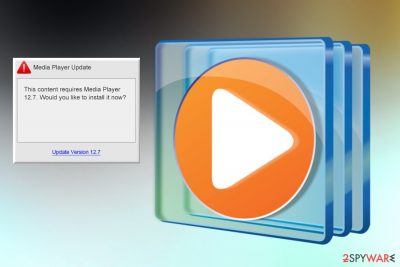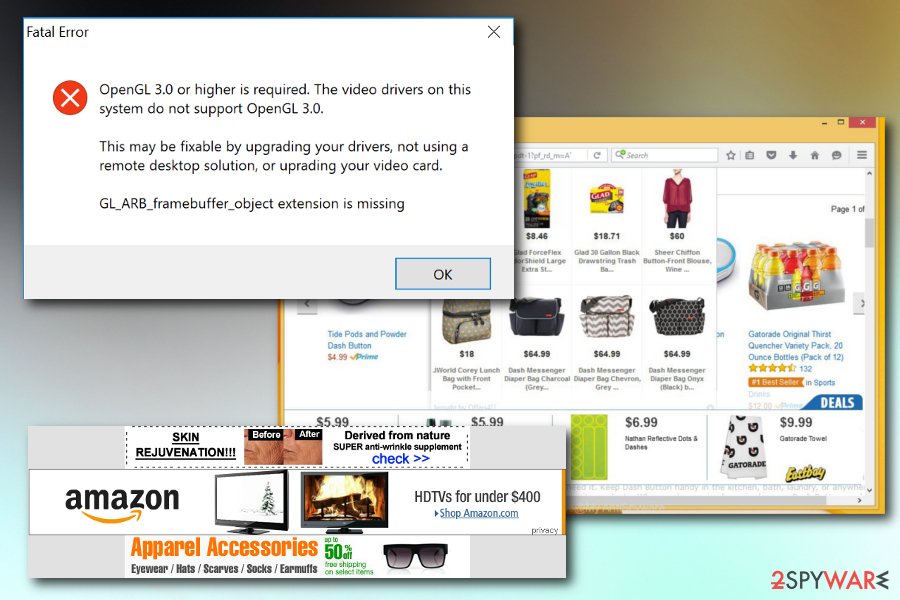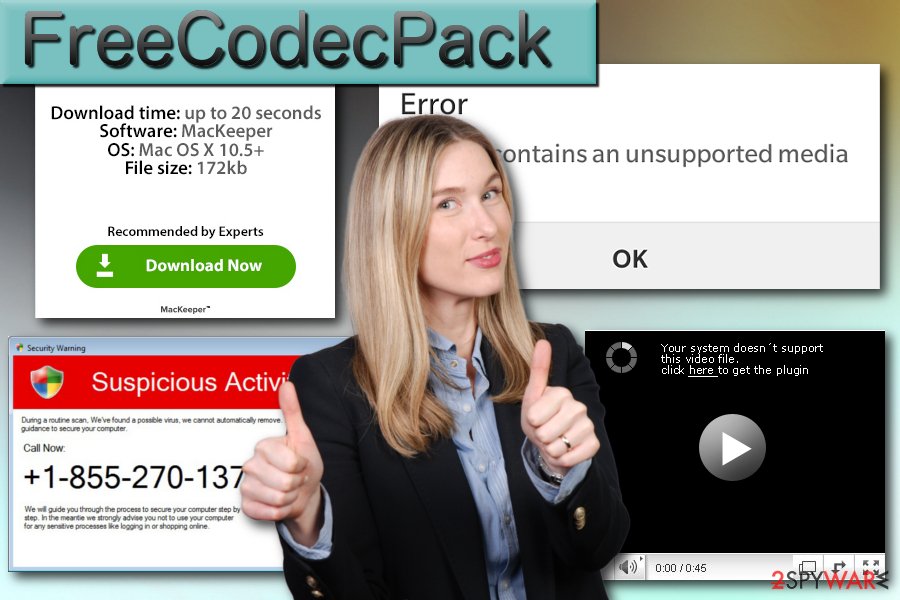FreeCodecPack (Removal Guide) - updated Mar 2018
FreeCodecPack Removal Guide
What is FreeCodecPack?
FreeCodecPack is a questionable application that brings intrusive ads to your browser

FreeCodecPack is advertised as an important and useful computer component that allows users to view various file formats for free. After closely looking into the suspicious program's functionality, security experts could quickly determine that this rogue software is adware[1] that gets delivered via software bundling. Thus, users typically do not install it willingly.
| SUMMARY | |
| Name | FreeCodecPack |
|---|---|
| Type | Adware |
| Disguised as | Codec pack |
| Risk | Medium. However, might lead to malware infiltration and data leak |
| Infected systems | All versions of Windows OS |
| Distribution | Bundling, unsafe websites |
| Elimination | For quick deletion, download FortectIntego |
Soon after infiltration, the dubious application attaches itself to the browser as an add-on and creates a FreeCodecPack folder, where all the primary files are executed. This helps the app to strengthen its position in the system, modify Windows registry and deliver sponsored content via ads, pop-ups, deals, banners, coupons, redirects, etc.
This way, adware creators can boost the traffic to unknown internet sites. By doing so, both parties benefit – adware authors get pay-per-click revenue, while less-known retailers increase their sales.
However, the user, who is left in between, does not benefit at all. The victim has to deal with ads whether he/she wants it or not. Therefore, we urge users not to tolerate such behavior from adware creators and remove FreeCodecPack virus immediately. FortectIntego can help with a swift elimination (although you can pick any other security software of your choice).
As soon as your PC gets infected with a FreeCodecPack virus, adverts are delivered directly into your Google Chrome, Internet Explorer, Mozilla Firefox or other browsers and typically display the following text at the corner of the ad:
- “Powered by FreeCodecPack”
- “Ads by FreeCodecPack”
- “Waiting for FreeCodecPack”
- “Connected to FreeCodecPack”, etc.
However, by far the most dangerous trait of FreeCodecPack is its redirecting tendencies. Security experts[2] warn that FreeCodecPack redirects can lead to both reliable and really suspicious third-party websites, so the best that you can do to prevent exposure to unsafe websites is to ignore each of the ads and never click on the content you got redirected to. Otherwise, you can get infected with malware or get your personal information stolen.

Finally, a noteworthy fact is that FreeCodecPack installs tracking software and can monitor your browsing activities on a daily basis. Recent malware research has shown that it may engage DOM storage data,[3] web beacons, Flash cookies, HTTP cookies and other means for collecting and storing personally non-identifiable information, such as IP address, PC's location, email address, search terms, websites visited and so on.
If the developers would use such data only for improving the service that would be OK. However, it seems that developers have found a way to earn more money which is to share/sell gathered data with other third-party advertisers. All in all, we highly recommend FreeCodecPack removal if you noticed its suspicious activity.
Codec packs are not needed for playing video files
Users often download codec packs because their system cannot run certain video files correctly. Thus, they often look for solutions in third-party websites. Others might never encounter such problems and merely acquire the unwanted application with bundled software. Nevertheless, FreeCodecPack removal should be a priority of both groups of people.
If you run into problems while playing specific video files, we suggest downloading a video player that has pre-installed codecs and will handle any media file without external help. One of such players is VLC – a well-respected video player amongst many users. Once you download such player, you will never have to worry about codecs again.

Adware is distributed in software bundles
Users are typically careless when it comes to internet safety. After all, they never think that something unpleasant can happen to them. It can, and it will unless you take some extra precautions and protect yourself from unwanted software.
The most prominent adware and other PUP distribution method is via software bundling. These unwanted programs are included as additional components inside (mostly) third-party installers. However, even the most popular programs and its updates (like Adobe Flash) may hide optional installs.
Thus, to avoid unnecessary troubles, follow these simple tips:
- do not rush the installation process and read the instructions carefully;
- read through EULA and Privacy Policy;
- when prompted, always opt for Advanced/Custom installation mode and avoid Recommended/Quick setup;
- when you see the additional programs in Advanced settings, remove all the tick marks with add-ons, toolbars, codec packs, system optimizers and similar;

Easy ways to remove FreeCodecPack from the system
FreeCodecPack removal can be performed both manually and automatically. We have both methods covered, so pick the one that suits you best.
Automatic FreeCodecPack virus elimination is recommended for all users who are not that familiar with computer processes, and/or would like an easy and quick solution to the problem. Simply download one of the respected security programs and bring it up to date. The last step is to scan the system and let security software handle the rest.
For those who dislike additional software on their PCs, are familiar with computers and would like to remove FreeCodecPack manually, we advise checking our step-by-step guide below. Be attentive while executing this method as incorrect procedure might lead to reinfection of the virus. We must remind you that this method will also not protect you from future infections.
You may remove virus damage with a help of FortectIntego. SpyHunter 5Combo Cleaner and Malwarebytes are recommended to detect potentially unwanted programs and viruses with all their files and registry entries that are related to them.
Getting rid of FreeCodecPack. Follow these steps
Uninstall from Windows
If you want to uninstall FreeCodecPack form Windows OS, follow these steps:
Instructions for Windows 10/8 machines:
- Enter Control Panel into Windows search box and hit Enter or click on the search result.
- Under Programs, select Uninstall a program.

- From the list, find the entry of the suspicious program.
- Right-click on the application and select Uninstall.
- If User Account Control shows up, click Yes.
- Wait till uninstallation process is complete and click OK.

If you are Windows 7/XP user, proceed with the following instructions:
- Click on Windows Start > Control Panel located on the right pane (if you are Windows XP user, click on Add/Remove Programs).
- In Control Panel, select Programs > Uninstall a program.

- Pick the unwanted application by clicking on it once.
- At the top, click Uninstall/Change.
- In the confirmation prompt, pick Yes.
- Click OK once the removal process is finished.
Delete from macOS
Remove items from Applications folder:
- From the menu bar, select Go > Applications.
- In the Applications folder, look for all related entries.
- Click on the app and drag it to Trash (or right-click and pick Move to Trash)

To fully remove an unwanted app, you need to access Application Support, LaunchAgents, and LaunchDaemons folders and delete relevant files:
- Select Go > Go to Folder.
- Enter /Library/Application Support and click Go or press Enter.
- In the Application Support folder, look for any dubious entries and then delete them.
- Now enter /Library/LaunchAgents and /Library/LaunchDaemons folders the same way and terminate all the related .plist files.

Remove from Microsoft Edge
Delete unwanted extensions from MS Edge:
- Select Menu (three horizontal dots at the top-right of the browser window) and pick Extensions.
- From the list, pick the extension and click on the Gear icon.
- Click on Uninstall at the bottom.

Clear cookies and other browser data:
- Click on the Menu (three horizontal dots at the top-right of the browser window) and select Privacy & security.
- Under Clear browsing data, pick Choose what to clear.
- Select everything (apart from passwords, although you might want to include Media licenses as well, if applicable) and click on Clear.

Restore new tab and homepage settings:
- Click the menu icon and choose Settings.
- Then find On startup section.
- Click Disable if you found any suspicious domain.
Reset MS Edge if the above steps did not work:
- Press on Ctrl + Shift + Esc to open Task Manager.
- Click on More details arrow at the bottom of the window.
- Select Details tab.
- Now scroll down and locate every entry with Microsoft Edge name in it. Right-click on each of them and select End Task to stop MS Edge from running.

If this solution failed to help you, you need to use an advanced Edge reset method. Note that you need to backup your data before proceeding.
- Find the following folder on your computer: C:\\Users\\%username%\\AppData\\Local\\Packages\\Microsoft.MicrosoftEdge_8wekyb3d8bbwe.
- Press Ctrl + A on your keyboard to select all folders.
- Right-click on them and pick Delete

- Now right-click on the Start button and pick Windows PowerShell (Admin).
- When the new window opens, copy and paste the following command, and then press Enter:
Get-AppXPackage -AllUsers -Name Microsoft.MicrosoftEdge | Foreach {Add-AppxPackage -DisableDevelopmentMode -Register “$($_.InstallLocation)\\AppXManifest.xml” -Verbose

Instructions for Chromium-based Edge
Delete extensions from MS Edge (Chromium):
- Open Edge and click select Settings > Extensions.
- Delete unwanted extensions by clicking Remove.

Clear cache and site data:
- Click on Menu and go to Settings.
- Select Privacy, search and services.
- Under Clear browsing data, pick Choose what to clear.
- Under Time range, pick All time.
- Select Clear now.

Reset Chromium-based MS Edge:
- Click on Menu and select Settings.
- On the left side, pick Reset settings.
- Select Restore settings to their default values.
- Confirm with Reset.

Remove from Mozilla Firefox (FF)
Reset your Mozilla Firefox settings after complete PUP elimination:
Remove dangerous extensions:
- Open Mozilla Firefox browser and click on the Menu (three horizontal lines at the top-right of the window).
- Select Add-ons.
- In here, select unwanted plugin and click Remove.

Reset the homepage:
- Click three horizontal lines at the top right corner to open the menu.
- Choose Options.
- Under Home options, enter your preferred site that will open every time you newly open the Mozilla Firefox.
Clear cookies and site data:
- Click Menu and pick Settings.
- Go to Privacy & Security section.
- Scroll down to locate Cookies and Site Data.
- Click on Clear Data…
- Select Cookies and Site Data, as well as Cached Web Content and press Clear.

Reset Mozilla Firefox
If clearing the browser as explained above did not help, reset Mozilla Firefox:
- Open Mozilla Firefox browser and click the Menu.
- Go to Help and then choose Troubleshooting Information.

- Under Give Firefox a tune up section, click on Refresh Firefox…
- Once the pop-up shows up, confirm the action by pressing on Refresh Firefox.

Remove from Google Chrome
Delete malicious extensions from Google Chrome:
- Open Google Chrome, click on the Menu (three vertical dots at the top-right corner) and select More tools > Extensions.
- In the newly opened window, you will see all the installed extensions. Uninstall all the suspicious plugins that might be related to the unwanted program by clicking Remove.

Clear cache and web data from Chrome:
- Click on Menu and pick Settings.
- Under Privacy and security, select Clear browsing data.
- Select Browsing history, Cookies and other site data, as well as Cached images and files.
- Click Clear data.

Change your homepage:
- Click menu and choose Settings.
- Look for a suspicious site in the On startup section.
- Click on Open a specific or set of pages and click on three dots to find the Remove option.
Reset Google Chrome:
If the previous methods did not help you, reset Google Chrome to eliminate all the unwanted components:
- Click on Menu and select Settings.
- In the Settings, scroll down and click Advanced.
- Scroll down and locate Reset and clean up section.
- Now click Restore settings to their original defaults.
- Confirm with Reset settings.

Delete from Safari
Remove unwanted extensions from Safari:
- Click Safari > Preferences…
- In the new window, pick Extensions.
- Select the unwanted extension and select Uninstall.

Clear cookies and other website data from Safari:
- Click Safari > Clear History…
- From the drop-down menu under Clear, pick all history.
- Confirm with Clear History.

Reset Safari if the above-mentioned steps did not help you:
- Click Safari > Preferences…
- Go to Advanced tab.
- Tick the Show Develop menu in menu bar.
- From the menu bar, click Develop, and then select Empty Caches.

After uninstalling this potentially unwanted program (PUP) and fixing each of your web browsers, we recommend you to scan your PC system with a reputable anti-spyware. This will help you to get rid of FreeCodecPack registry traces and will also identify related parasites or possible malware infections on your computer. For that you can use our top-rated malware remover: FortectIntego, SpyHunter 5Combo Cleaner or Malwarebytes.
How to prevent from getting adware
Stream videos without limitations, no matter where you are
There are multiple parties that could find out almost anything about you by checking your online activity. While this is highly unlikely, advertisers and tech companies are constantly tracking you online. The first step to privacy should be a secure browser that focuses on tracker reduction to a minimum.
Even if you employ a secure browser, you will not be able to access websites that are restricted due to local government laws or other reasons. In other words, you may not be able to stream Disney+ or US-based Netflix in some countries. To bypass these restrictions, you can employ a powerful Private Internet Access VPN, which provides dedicated servers for torrenting and streaming, not slowing you down in the process.
Data backups are important – recover your lost files
Ransomware is one of the biggest threats to personal data. Once it is executed on a machine, it launches a sophisticated encryption algorithm that locks all your files, although it does not destroy them. The most common misconception is that anti-malware software can return files to their previous states. This is not true, however, and data remains locked after the malicious payload is deleted.
While regular data backups are the only secure method to recover your files after a ransomware attack, tools such as Data Recovery Pro can also be effective and restore at least some of your lost data.
- ^ Adware. Trend Micro. Security experts.
- ^ Virusai. Virusai. Lithuanian security experts.
- ^ Document Object Model. Wikipedia. The Free Encyclopedia.























